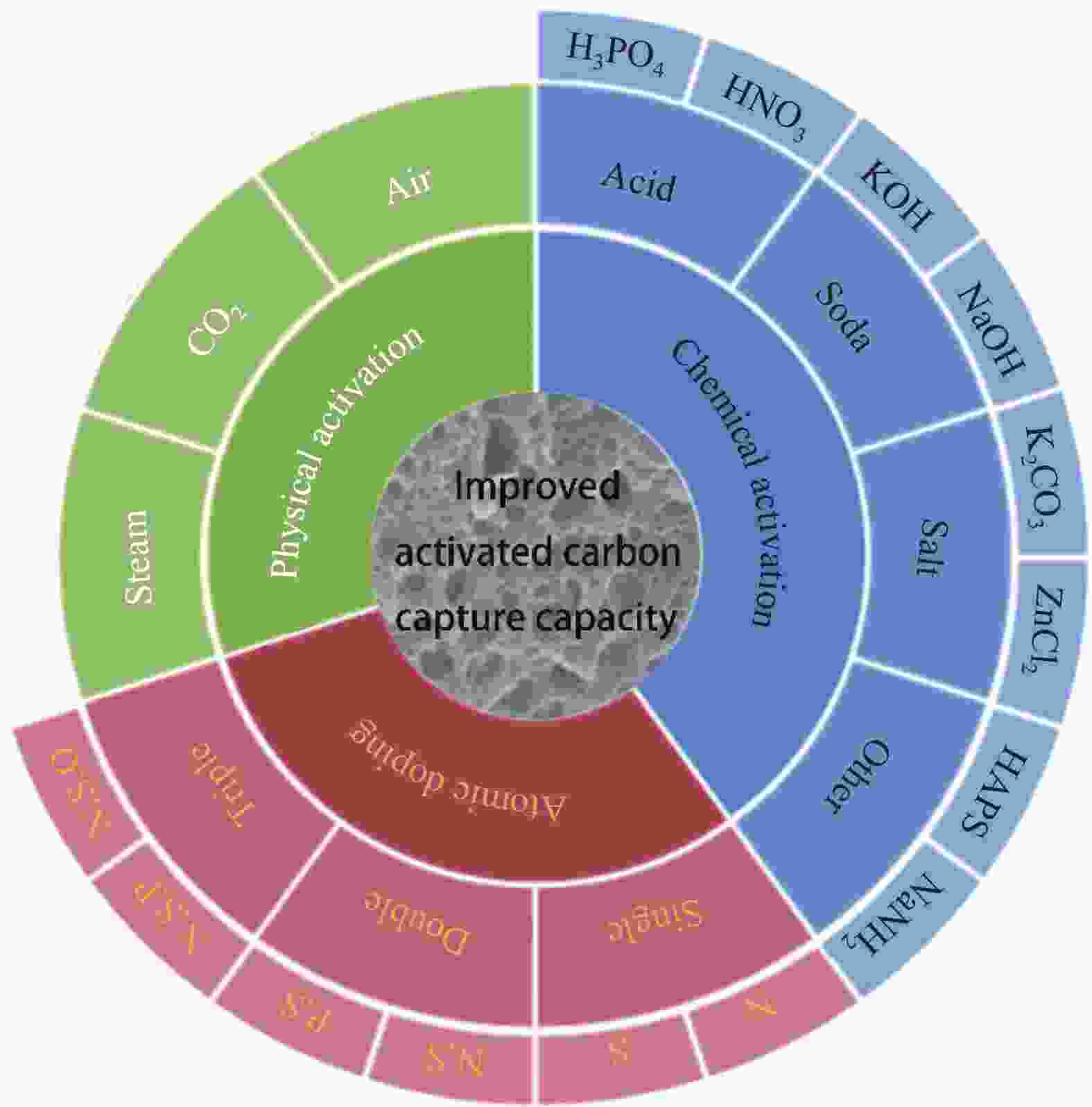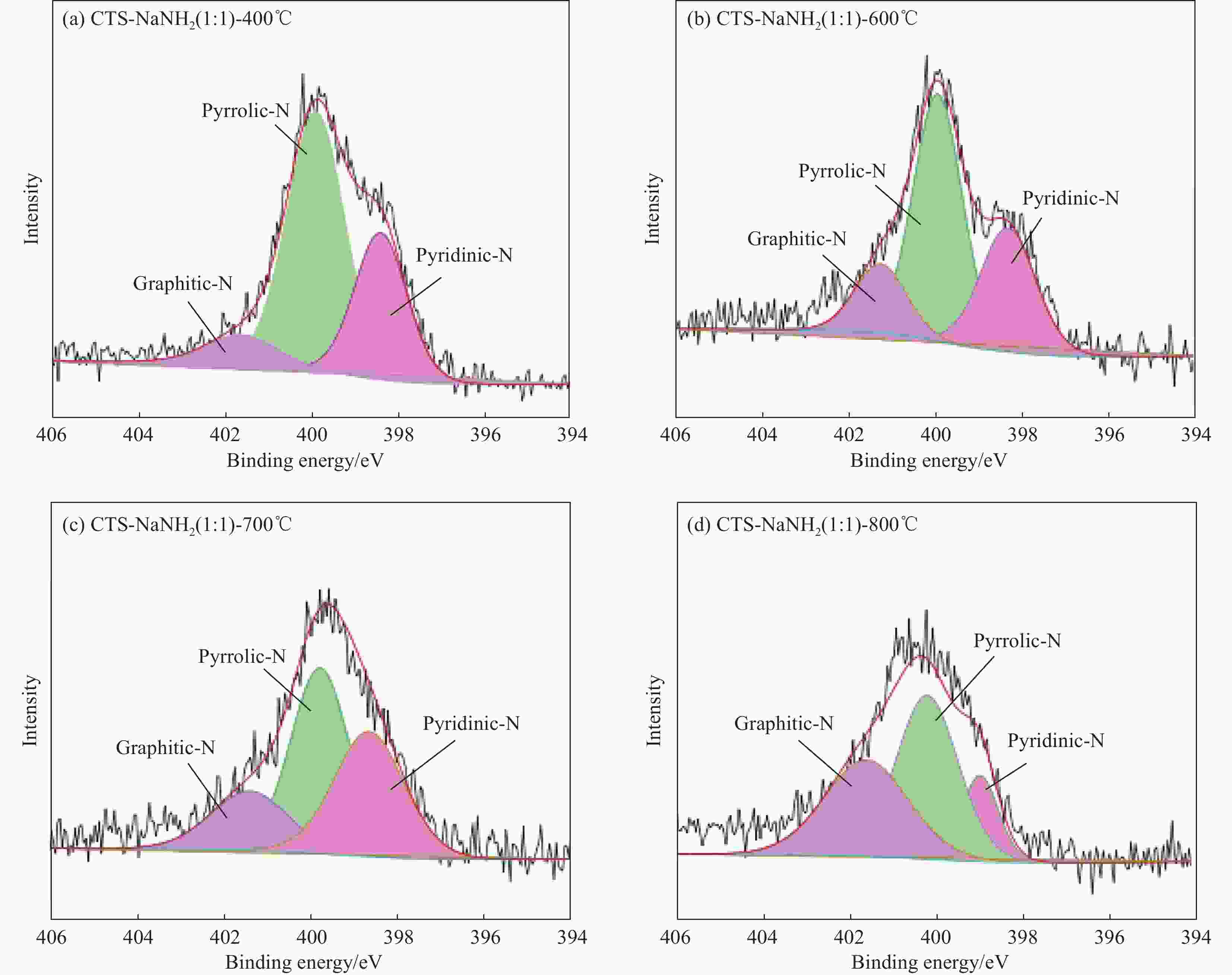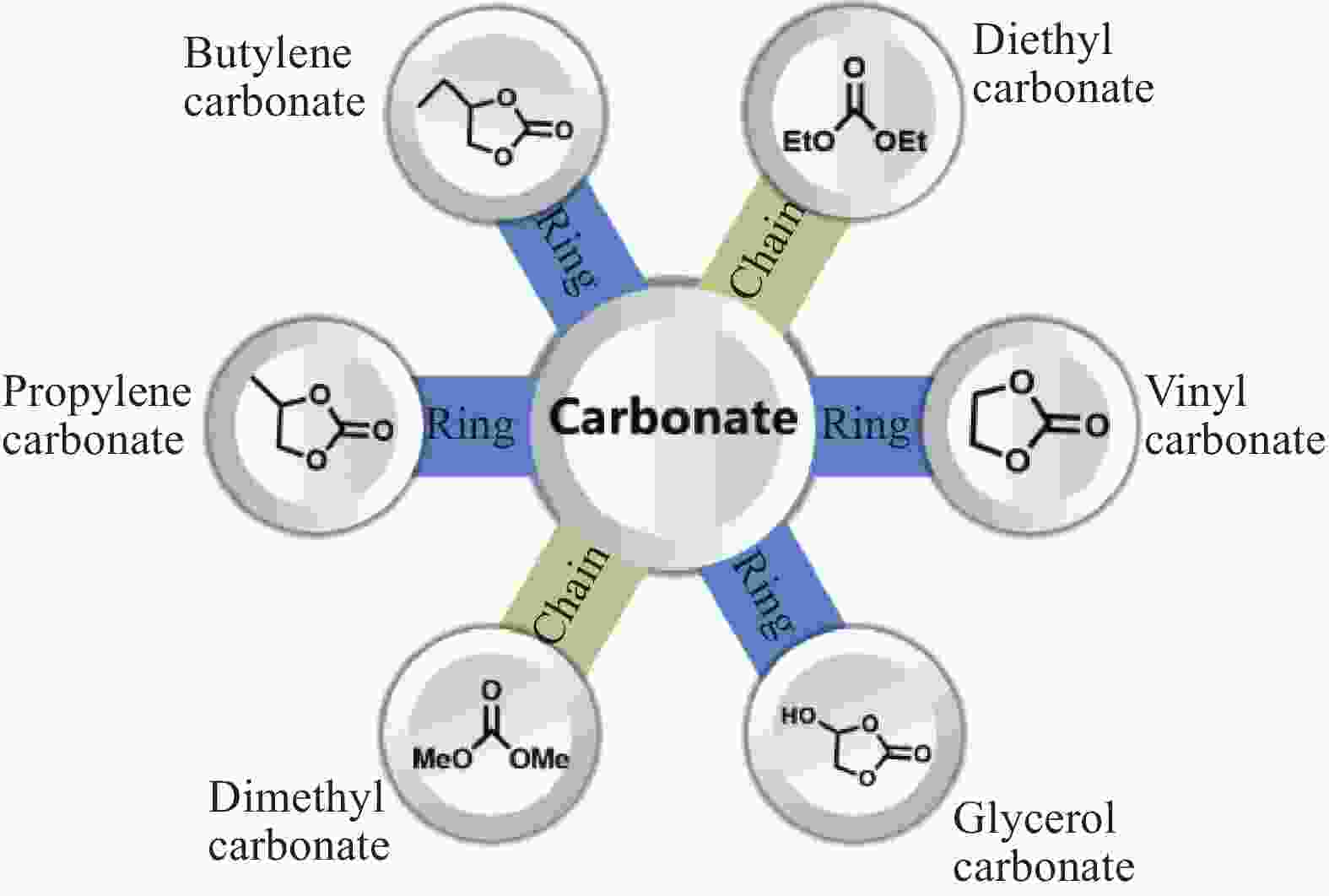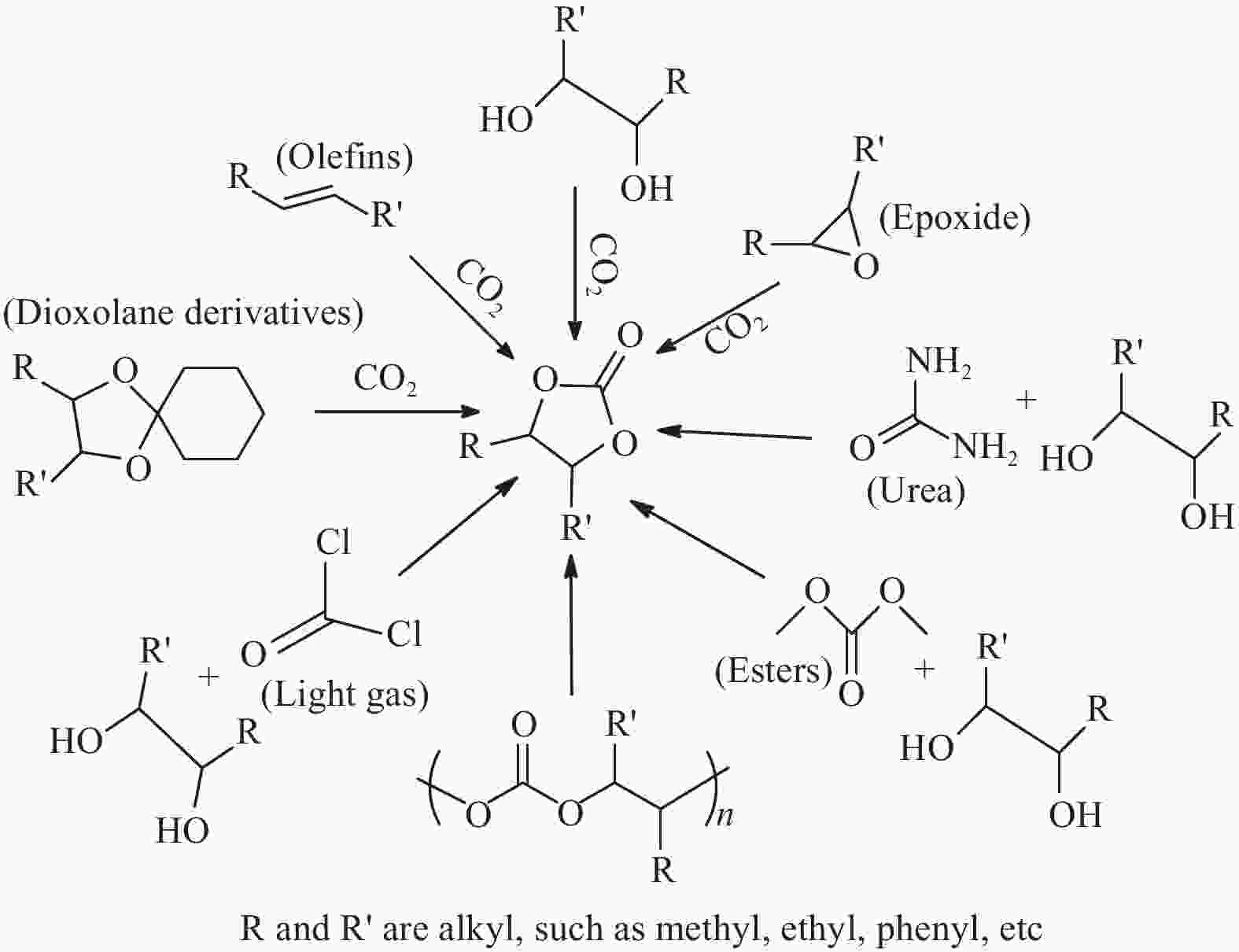Application of biomass chitosan-based composites for CO2 separation and capture and resource utilization
-
摘要: 二氧化碳过度排放导致的全球变暖、海平面上升和气候恶化等生态环境问题日益显著,亟需探寻新型处理技术和生物质材料来缓解这一问题。本文综述了生物质壳聚糖在二氧化碳分离、捕获和资源化利用领域的研究进展;详细阐述了壳聚糖膜对CO2的分离机制及提高膜分离性能的方法;归纳了增强壳聚糖基活性炭对CO2捕获性能的方法;对利用壳聚糖基催化剂将CO2转化为碳酸酯、甲烷和烯烃等增值品的相关研究进行了总结。最后,对生物质壳聚糖在未来助力“双碳”战略目标实现过程中的发展趋势进行了展望。Abstract: There is an urgent need to explore new treatment technologies and biomass materials to mitigate the growing ecological problems of global warming, sea level rise and climate degradation caused by excessive carbon dioxide emissions. This paper reviews the research progress of biomass chitosan in CO2 separation, capture and resource utilization; details the mechanism of CO2 separation by chitosan membranes and methods to improve membrane separation performance; summarizes the methods to enhance the CO2 capture performance of chitosan-based activated carbon; and summarizes the research on the conversion of CO2 into value-added products such as carbonate, methane and olefin by chitosan-based catalysts. Finally, the future development trend of biomass chitosan in the process of helping to achieve the "double carbon" strategic goal is presented.
-
Key words:
- carbon peak /
- carbon neutrality /
- biomass materials /
- chitosan /
- carbon dioxide /
- separation /
- capture /
- resource utilization
-
图 4 利用响应曲面法分析不同因素对壳聚糖-漂白土CO2去除率的影响:((a), (d)) 温度和CO2浓度对吸附量的影响;((b), (e))温度和CTS用量对吸附量的影响;((c), (f)) CTS用量和CO2浓度对吸附量的影响[46]
Figure 4. Effect of different factors on CO2 removal from chitosan-bleached soil using response surface methodology: ((a), (d)) Effect of temperature and CO2 concentration on adsorption capacity; ((b), (e)) Effect of temperature and CTS dosage on adsorption capacity; ((c), (f)) Effect of CTS dosage and CO2 concentration on adsorption capacity[46]
表 1 利用壳聚糖(CTS)/羧甲基壳聚糖(CMC)与填料制备混合基质膜
Table 1. Preparation of mixed matrix membrane using chitosan (CTS)/carboxymethyl chitosan (CMC) and filler
Membrane Packing loading rate Penetration rate of CO2 CO2/N2 selectivity Separation condition Literature CMC/PZ PZ,20% 89 GPU 103 80℃, 120 kPa [22] CTS/GO/PVAm HPEI-GO, 2% and 3% 36 GPU (2%) 107 (3%) CO2 : N2 =10 : 90 [23] CTS/ZIF-8/IL ZIF-8,10% (5413±191) Barrer 11.5 50℃, 200 kPa [24] CTS/SF/GNP GNP,0.5% 159 GPU 93 90℃, 200 kPa [25] CMC/HT HT,1% 70 GPU 13 90℃, 200 kPa [26] Notes: PZ—Piperazine; PVAm—Polyvinylamine; HPEI-GO—Hyperbranched polyethyleneimine grafted graphene oxide; ZIF-8—Zinc(2-methylimidazole); IL—Ionic liquid; GNP—Graphene nanoparticles; HT—Hydrotalcite; SF—Silk fibroin. 表 2 通过原子掺杂的方法制备壳聚糖基活性炭
Table 2. Preparation of chitosan-based activated carbon by atomic doping method
Carbon Source Source of heteroatoms Activator Adsorption performance Reusability Literature CTS CTS provides N atoms K2CO3 100 kPa, 25℃, adsorption capacity was 3.86 mmol/g Adsorption capacity unchanged
after five cycles[37] CTS TMP and CTS provide N atoms KOH 0℃, 100 kPa, the maximum CO2 adsorption capacity was 4.74 mmol/g After ten cycles, the adsorption capacity decreased by 8% [38] CTS HMT and CTS provide N atoms ZnCl2 Adsorption capacity was smaller than undoped activated carbon – [39] CTS NaNH2 and CTS provide N atoms NaNH2 0℃, 100 kPa, the adsorption amount of CO2 was 6.33 mmol/g After three cycles, the adsorption
effect remains almost constant
[35]CTS,
SLCTS and SL provide N and S atoms, respectively KOH 0℃, 100 kPa, the adsorption amount of CO2 was 215.2 mg/g After three cycles, the adsorption capacity has decreased by 20% [40] CTS CTS and HAPS provide N and S atoms, respectively HAPS 25℃, 100 kPa, the adsorption amount of CO2 was 2.4 mmol/g – [41] CTS CTS provides the N atoms and phytic acid provides the P atoms NaNO3 100 kPa, the adsorption amount of CO2 was 3.02 mmol/g After twenty cycles, the adsorption capacity remains unchanged [42] Notes: TMP—2, 4, 6-triaminopyrimidine; HMT—Hexamethylenetetramine; SL—Sodium lignosulfonate. 表 3 改性壳聚糖基吸附剂用于CO2捕获
Table 3. Modified chitosan-based sorbents for CO2 capture
Adsorbent Modification method Modification advantages Introduction of substances Adsorption performance Literature Furfuryl-
imine-CTS
fibersImine formation The introduction of imine groups produced a
highly nucleophilic active surface
20℃, 61 kPa, the adsorption
amount was 0.978 mmol/g[47] Chitosan
based
aerogelGraft Carboxyl, amino, imine, amide and other
groups are introduced
35℃, the adsorption amount
was 5.48 mmol/g[48] CTS/LS hydrogel Cross-link The introduction of Li+ and basic group, enhances the acid-base effect and electrostatic effect 
100 kPa, 25℃, the maximum
adsorption amount
was 67.9 mg/g[49] CTS/MWCNTs Graft Increase the surface area of CTS and introduce hydroxyl and carboxyl groups 
25℃, 100 kPa, the maximum
adsorption amount
was 1.92 cm3/g[50] Notes: MWCNTs—Multi-walled carbon nanotubes; LS—Lithium sulfonate. 表 4 利用CO2制备其他化学增值品
Table 4. Preparation of other chemical value-added products using CO2
Catalyst Raw materials Reaction condition Product Production efficiency Reusability Literature CTS/KOH/
EnzymesBicarbonate, CaCl2, CO2 pH 8, 35℃ CaCO3 152 mg of CaCO3 per gram of CO2 No change after 7 repetitions [61] K-doped Fe/CTS complexes CO2, H2 330℃, 1.5 MPa Olefins CO2 conversion rate was 41% and
olefin yield was 20.4%– [62] CTS/CA/SiO2 CaCl2, CO2 pH 7.6, 25℃ CaCO3 230 mg CaCO3 were gotten after 10 min Can be reused up to 30 times [63] CTS/PEG Ethanol, CO2, H2 6 MPa, 170℃ Methanol Resulting methanol concentration was 472 mmol/L Can be recycled up to 3 times [64] C/A/PEC CaCl2, CO2 pH 8.2, pH 9.5 CaCO3 1 g of catalyst can catalyze the
synthesis of 253 mg of CaCO3No change after 10 repetitions [65] Cu/TiO2/CTS H2O, CO2 Xenon lamp irradiation Methane Yield of methane was 5.34 μmol/g – [66] Notes: CA—Carbonic anhydrase; PEG—Polyethyleneglycol; C/A/PEC—Chitosan-alginate polyelectrolyte complex. -
[1] NAGASE T, MIYAKAWA M, NISHIOKA M, et al. Microwave-assisted green synthesis of mesoporous zeolite adsorbents for direct air capture of CO2[J]. Chemistry Letters, 2022, 51(3): 296-299. doi: 10.1246/cl.210687 [2] YU S, LI S, HUANG S, et al. Covalently bonded zeolitic imidazolate frameworks and polymers with enhanced compatibility in thin film nanocomposite membranes for gas separation[J]. Journal of Membrane Science, 2017, 540: 155-164. doi: 10.1016/j.memsci.2017.06.047 [3] CHABAN V V, ANDREEVA N A. Extensively amino-functionalized graphene captures carbon dioxide[J]. Physical Chemistry Chemical Physics, 2022, 24(42): 25801-25815. doi: 10.1039/D2CP03235J [4] 汤琦龙, 傅晶依, 窦信, 等. 改性壳聚糖磁性纳米材料的研究进展[J]. 复合材料学报, 2022, 39(3): 1017-1025TANG Qilong, FU Jingyi, DOU Xin, et al. Research progress of modified chitosan magnetic nanomaterials[J]. Acta Materiae Compositae Sinica, 2022, 39(3): 1017-1025(in Chinese) [5] RANGNEKAR N, MITTAL N, ELYASSI B, et al. Zeolite membranes-A review and comparison with MOFs[J]. Chemical Society Reviews, 2015, 44(20): 7128-7154. doi: 10.1039/C5CS00292C [6] ITO A, SATO M, ANMA T. Permeability of CO2 through chitosan membrane swollen by water vapor in feed gas[J]. Die Angewandte Makromolekulare Chemie: Applied Macromolecular Chemistry and Physics, 1997, 248(1): 85-94. doi: 10.1002/apmc.1997.052480105 [7] WEINKAUF D H, KIM H D, PAUL D R. Gas transport properties of liquid crystalline poly (p-phenyleneterephthalamide)[J]. Macromolecules, 1992, 25(2): 788-796. doi: 10.1021/ma00028a044 [8] EL-AZZAMI L A, GRULKE E A. Dual mode model for mixed gas permeation of CO2, H2, and N2 through a dry chitosan membrane[J]. Journal of Polymer Science Part B: Polymer Physics, 2007, 45(18): 2620-2631. doi: 10.1002/polb.21236 [9] REN J, XUAN H, GE L. Double network self-healing chitosan/dialdehyde starch-polyvinyl alcohol film for gas separation[J]. Applied Surface Science, 2019, 469: 213-219. doi: 10.1016/j.apsusc.2018.11.001 [10] ZHANG H, TIAN H, ZHANG J, et al. Facilitated transport membranes with an amino acid salt for highly efficient CO2 separation[J]. International Journal of Greenhouse Gas Control, 2018, 78: 85-93. doi: 10.1016/j.ijggc.2018.07.014 [11] LI N, WANG Z, WANG J. Water-swollen carboxymethyl chitosan (CMC)/polyamide (PA) membranes with octopus-branched nanostructures for CO2 capture[J]. Journal of Membrane Science, 2022, 642: 119946. doi: 10.1016/j.memsci.2021.119946 [12] DANCKWERTS P V. The reaction of CO2 with ethanolamines[J]. Chemical Engineering Science, 1979, 34(4): 443-446. doi: 10.1016/0009-2509(79)85087-3 [13] PRASAD B, MANDAL B. CO2 separation performance by chitosan/tetraethylenepentamine/poly(ether sulfone) composite membrane[J]. Journal of Applied Polymer Science, 2017, 134(34): 45206. doi: 10.1002/app.45206 [14] PRASAD B, MANDAL B. Preparation and characterization of CO2-selective facilitated transport membrane composed of chitosan and poly (allylamine) blend for CO2/N2 separation[J]. Journal of Industrial and Engineering Chemistry, 2018, 66: 419-429. doi: 10.1016/j.jiec.2018.06.009 [15] PRASAD B, MANDAL B. Moisture responsive and CO2 selective biopolymer membrane containing silk fibroin as a green carrier for facilitated transport of CO2[J]. Journal of Membrane Science, 2018, 550: 416-426. doi: 10.1016/j.memsci.2017.12.061 [16] DE MORAES M A, NOGUEIRA G M, WESKA R F, et al. Preparation and characterization of insoluble silk fibroin/chitosan blend films[J]. Polymers, 2010, 2(4): 719-727. doi: 10.3390/polym2040719 [17] EL-AZZAMI L A, GRULKE E A. Carbon dioxide separation from hydrogen and nitrogen: Facilitated transport in arginine salt-chitosan membranes[J]. Journal of Membrane Science, 2009, 328(1-2): 15-22. doi: 10.1016/j.memsci.2008.08.038 [18] SHEN J N, YU C C, ZENG G N, et al. Preparation of a facilitated transport membrane composed of carboxymethyl chitosan and polyethylenimine for CO2/N2 separation[J]. International Journal of Molecular Sciences, 2013, 14(2): 3621-3638. doi: 10.3390/ijms14023621 [19] BORGOHAIN R, JAIN N, PRASAD B, et al. Carboxymethyl chitosan/carbon nanotubes mixed matrix membranes for CO2 separation[J]. Reactive and Functional Polymers, 2019, 143: 104331. doi: 10.1016/j.reactfunctpolym.2019.104331 [20] KATARE A, SHARMA S, MANDAL B. Effects of L-lysine-conjugated-graphene oxide as a nanofiller on the CO2 separation performance of mixed matrix chitosan membrane[J]. Indian Chemical Engineer, 2023, 65(2): 168-179. [21] BORGOHAIN R, MANDAL B. Thermally stable and moisture responsive carboxymethyl chitosan/dendrimer/hydrotalcite membrane for CO2 separation[J]. Journal of Membrane Science, 2020, 608: 118214. doi: 10.1016/j.memsci.2020.118214 [22] BORGOHAIN R, PRASAD B, MANDAL B. Synthesis and characterization of water-soluble chitosan membrane blended with a mobile carrier for CO2 separation[J]. Separation and Purification Technology, 2019, 222: 177-187. doi: 10.1016/j.seppur.2019.04.038 [23] SHEN Y, WANG H, LIU J, et al. Enhanced performance of a novel polyvinyl amine/chitosan/graphene oxide mixed matrix membrane for CO2 capture[J]. ACS Sustainable Chemistry & Engineering, 2015, 3(8): 1819-1829. [24] CASADO-COTERILLO C, FERNÁNDEZ-BARQUÍN A, ZORNOZA B, et al. Synthesis and characterisation of MOF/ionic liquid/chitosan mixed matrix membranes for CO2/N2 separation[J]. RSC Advances, 2015, 5(124): 102350-102361. doi: 10.1039/C5RA19331A [25] PRASAD B, MANDAL B. Graphene-incorporated biopolymeric mixed-matrix membrane for enhanced CO2 separation by regulating the support pore filling[J]. ACS Applied Materials & interfaces, 2018, 10(33): 27810-27820. [26] BORGOHAIN R, MANDAL B. High-speed CO2 transport channel containing carboxymethyl chitosan/hydrotalcite membrane for CO2 separation[J]. Journal of Applied Polymer Science, 2020, 137(21): 48715. doi: 10.1002/app.48715 [27] MALINI K, SASI M, MEGHANATH R, et al. Effect of barium activation on chitosan derived carbon: Enhancement of CO2 adsorption capacity[J]. International Journal of Environmental Analytical Chemistry, 2023, 103(18): 7042-7054. [28] MIYAJIMA N, TAKIZAWA K, SAKANE H. Surface characterization of chitosan and cellulose-derived porous carbons with K2CO3 activation and its application to water and ethene adsorption[J]. Journal of Porous Materials, 2021, 28(6): 1689-1695. doi: 10.1007/s10934-021-01116-x [29] NAZIR G, REHMAN A, PARK S J. Valorization of shrimp shell biowaste for environmental remediation: Efficient contender for CO2 adsorption and separation[J]. Journal of Environmental Management, 2021, 299: 113661. doi: 10.1016/j.jenvman.2021.113661 [30] KAMRAN U, PARK S J. Tuning ratios of KOH and NaOH on acetic acid-mediated chitosan-based porous carbons for improving their textural features and CO2 uptakes[J]. Journal of CO2 Utilization, 2020, 40: 101212. doi: 10.1016/j.jcou.2020.101212 [31] OTOWA T, NOJIMA Y, MIYAZAKI T. Development of KOH activated high surface area carbon and its application to drinking water purification[J]. Carbon, 1997, 35(9): 1315-1319. doi: 10.1016/S0008-6223(97)00076-6 [32] LI D, ZHOU J, ZHANG Z, et al. Improving low-pressure CO2 capture performance of N-doped active carbons by adjusting flow rate of protective gas during alkali activation[J]. Carbon, 2017, 114: 496-503. doi: 10.1016/j.carbon.2016.12.039 [33] LI J, BAO A, CHEN J, et al. A green route to CO2 adsorption on biomass chitosan derived nitrogen-doped micropore-dominated carbon nanosheets by different activators[J]. Journal of Environmental Chemical Engineering, 2022, 10(1): 107021. doi: 10.1016/j.jece.2021.107021 [34] SINGH G, TIBURCIUS S, RUBAN S M, et al. Pure and strontium carbonate nanoparticles functionalized microporous carbons with high specific surface areas derived from chitosan for CO2 adsorption[J]. Emergent Materials, 2019, 2: 337-349. doi: 10.1007/s42247-019-00050-8 [35] YANG C, ZHAO T, PAN H, et al. Facile preparation of N-doped porous carbon from chitosan and NaNH2 for CO2 adsorption and conversion[J]. Chemical Engineering Journal, 2022, 432: 134347. doi: 10.1016/j.cej.2021.134347 [36] SEVILLA M, VALLE-VIGÓN P, FUERTES A B. N-doped polypyrrole-based porous carbons for CO2 capture[J]. Advanced Functional Materials, 2011, 21(14): 2781-2787. doi: 10.1002/adfm.201100291 [37] FAN X, ZHANG L, ZHANG G, et al. Chitosan derived nitrogen-doped microporous carbons for high performance CO2 capture[J]. Carbon, 2013, 61: 423-430. doi: 10.1016/j.carbon.2013.05.026 [38] YANG Q, TENG D, QU J, et al. Solvent-free synthesis of N-doped porous carbons from chitosan for an efficient CO2 capture[J]. Industrial & Engineering Chemistry Research, 2021, 60(35): 13023-13030. [39] MALINI K, SELVAKUMAR D, KUMAR N S. Nitrogen doped activated carbon derived from chitosan/hexamethylenetetramine: Structural and CO2 adsorption properties[J]. Journal of Porous Materials, 2022, 29(5): 1539-1550. doi: 10.1007/s10934-022-01276-4 [40] SHAO L, WANG L, WANG J, et al. N-doped highly microporous carbon derived from the self-assembled lignin/chitosan composites beads for selective CO2 capture and efficient p-nitrophenol adsorption[J]. Separation and Purification Technology, 2023, 313: 123440. doi: 10.1016/j.seppur.2023.123440 [41] SHI J, CUI H, XU J, et al. Synthesis of nitrogen and sulfur co-doped carbons with chemical blowing method for CO2 adsorption[J]. Fuel, 2021, 305: 121505. doi: 10.1016/j.fuel.2021.121505 [42] XIAO J, WANG Y, ZHANG T C, et al. Phytic acid-induced self-assembled chitosan gel-derived N, P–co-doped porous carbon for high-performance CO2 capture and supercapacitor[J]. Journal of Power Sources, 2022, 517: 230727. doi: 10.1016/j.jpowsour.2021.230727 [43] SEVILLA M, PARRA J B, FUERTES A B. Assessment of the role of micropore size and N-doping in CO2 capture by porous carbons[J]. ACS Applied Materials & Interfaces, 2013, 5(13): 6360-6368. [44] BABARAO R, DAI S, JIANG D. Nitrogen-doped mesoporous carbon for carbon capture-A molecular simulation study[J]. The Journal of Physical Chemistry C, 2012, 116(12): 7106-7110. doi: 10.1021/jp301450m [45] THOTE J A, CHATTI R V, IYER K S, et al. N-doped mesoporous alumina for adsorption of carbon dioxide[J]. Journal of Environmental Sciences, 2012, 24(11): 1979-1984. doi: 10.1016/S1001-0742(11)61022-X [46] ISLAM M A, TAN Y L, ISLAM M A, et al. Chitosan-bleaching earth clay composite as an efficient adsorbent for carbon dioxide adsorption: Process optimization[J]. Colloids and Surfaces A: Physicochemical and Engineering Aspects, 2018, 554: 9-15. [47] MARIN L, DRAGOI B, OLARU N, et al. Nanoporous furfuryl-imine-chitosan fibers as a new pathway towards eco-materials for CO2 adsorption[J]. European Polymer Journal, 2019, 120: 109214. doi: 10.1016/j.eurpolymj.2019.109214 [48] HSAN N, DUTTA P K, KUMAR S, et al. Arginine containing chitosan-graphene oxide aerogels for highly efficient carbon capture and fixation[J]. Journal of CO2 Utilization, 2022, 59: 101958. doi: 10.1016/j.jcou.2022.101958 [49] LIU Z, MA R, DU W, et al. Radiation-initiated high strength chitosan/lithium sulfonate double network hydrogel/aerogel with porosity and stability for efficient CO2 capture[J]. RSC Advances, 2021, 11(33): 20486-20497. doi: 10.1039/D1RA03041H [50] HSAN N, DUTTA P K, KUMAR S, et al. Capture and chemical fixation of carbon dioxide by chitosan grafted multi-walled carbon nanotubes[J]. Journal of CO2 Utilization, 2020, 41: 101237. doi: 10.1016/j.jcou.2020.101237 [51] TAMBOLI A H, CHAUGULE A A, KIM H. Highly selective and multifunctional chitosan/ionic liquids catalyst for conversion of CO2 and methanol to dimethyl carbonates at mild reaction conditions[J]. Fuel, 2016, 166: 495-501. doi: 10.1016/j.fuel.2015.11.023 [52] BESSE V, ILLY N, DAVID G, et al. A chitosan derivative containing both carboxylic acid and quaternary ammonium moieties for the synthesis of cyclic carbonates[J]. ChemSusChem, 2016, 9(16): 2167-2173. doi: 10.1002/cssc.201600499 [53] XIAO L F, LI F W, XIA C G. An easily recoverable and efficient natural biopolymer-supported zinc chloride catalyst system for the chemical fixation of carbon dioxide to cyclic carbonate[J]. Applied Catalysis A: General, 2005, 279(1-2): 125-129. doi: 10.1016/j.apcata.2004.10.022 [54] ZHAO Y, TIAN J S, QI X H, et al. Quaternary ammonium salt-functionalized chitosan: An easily recyclable catalyst for efficient synthesis of cyclic carbonates from epoxides and carbon dioxide[J]. Journal of Molecular Catalysis A: Chemical, 2007, 271(1-2): 284-289. doi: 10.1016/j.molcata.2007.03.047 [55] KUMAR S E, SILVA J A, WANI M Y, et al. Carbon dioxide capture and conversion by an environmentally friendly chitosan based meso-tetrakis (4-sulfonatophenyl) porphyrin[J]. Carbohydrate Polymers, 2017, 175: 575-583. doi: 10.1016/j.carbpol.2017.08.031 [56] KUMAR S, WANI M Y, KOH J, et al. Carbon dioxide adsorption and cycloaddition reaction of epoxides using chitosan-graphene oxide nanocomposite as a catalyst[J]. Journal of Environmental Sciences, 2018, 69: 77-84. doi: 10.1016/j.jes.2017.04.013 [57] BORJIAN BOROUJENI M, LAEINI M S, NAZERI M T, et al. A novel and green in situ strategy for the synthesis of metallophthalocyanines on chitosan and investigation their catalytic activity in the CO2 fixation[J]. Catalysis Letters, 2019, 149: 2089-2097. doi: 10.1007/s10562-019-02740-8 [58] WU Y, ZUO S, ZHAO Y, et al. Biomass-derived metal-organic hybrids for CO2 transformation under ambient conditions[J]. Green Chemistry, 2020, 22(9): 2846-2851. doi: 10.1039/D0GC00212G [59] VALENTINI A, CARRENO N L V, PROBST L F D, et al. Ni: CeO2 nanocomposite catalysts prepared by polymeric precursor method[J]. Applied Catalysis A: General, 2006, 310: 174-182. doi: 10.1016/j.apcata.2006.05.037 [60] SEELAJAROEN H, SPIESS S, HABERBAUER M, et al. Enhanced methane producing microbial electrolysis cells for wastewater treatment using poly (neutral red) and chitosan modified electrodes[J]. Sustainable Energy & Fuels, 2020, 4(8): 4238-4248. [61] SHARMA A, BHATTACHARYA A, SHRIVASTAVA A. Biomimetic CO2 sequestration using purified carbonic anhydrase from indigenous bacterial strains immobilized on biopolymeric materials[J]. Enzyme and Microbial Technology, 2011, 48(4-5): 416-426. doi: 10.1016/j.enzmictec.2011.02.001 [62] CHEN B Y, DOBELE G, PLAVNIECE A, et al. Catalytic hydrogenation of CO2 to light olefins by using K-doped FeCx catalysts derived from the Fe-chitosan complex[J]. International Journal of Hydrogen Energy, 2023, 48(11): 4276-4286. doi: 10.1016/j.ijhydene.2022.11.010 [63] WOO K M, LEE I, HONG S G, et al. Crosslinked chitosan coating on magnetic mesoporous silica with pre-adsorbed carbonic anhydrase for carbon dioxide conversion[J]. Chemical Engineering Journal, 2015, 276: 232-239. doi: 10.1016/j.cej.2015.04.057 [64] KOTHANDARAMAN J, HELDEBRANT D J. Towards environmentally benign capture and conversion: Heterogeneous metal catalyzed CO2 hydrogenation in CO2 capture solvents[J]. Green Chemistry, 2020, 22(3): 828-834. doi: 10.1039/C9GC03449H [65] OVIYA M, SUKUMARAN V, GIRI S S. Immobilization and characterization of carbonic anhydrase purified from E. coli MO1 and its influence on CO2 sequestration[J]. World Journal of Microbiology and Biotechnology, 2013, 29: 1813-1820. doi: 10.1007/s11274-013-1343-z [66] SHE H, ZHAO Z, BAI W, et al. Enhanced performance of photocatalytic CO2 reduction via synergistic effect between chitosan and Cu : TiO2[J]. Materials Research Bulletin, 2020, 124: 110758. doi: 10.1016/j.materresbull.2019.110758 -






 下载:
下载:








